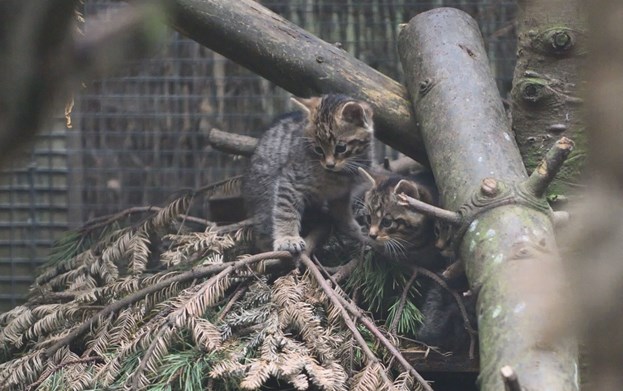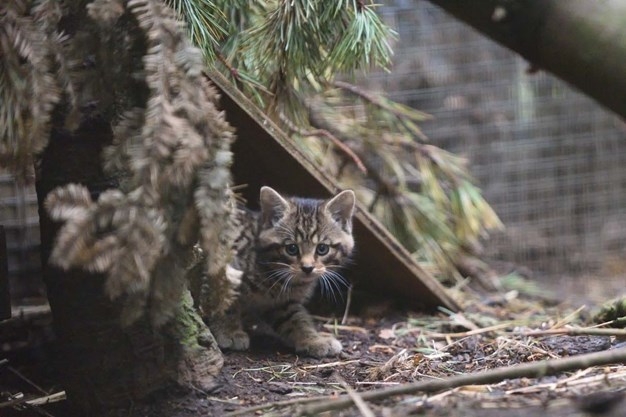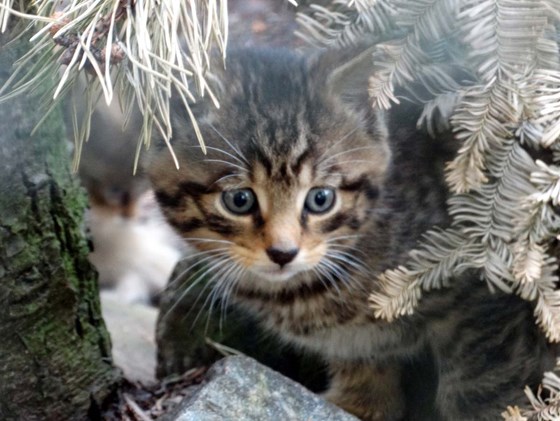Incredibly rare Scottish wildcat kittens born
13/07/2016 in Highland Wildlife Park

(Photo by Alex Riddell)
The Royal Zoological Society of Scotland (RZSS) is pleased to welcome not one but two litters of Scottish wildcat kittens at RZSS Highland Wildlife Park. These kittens will go on to play a vital role in the conservation of the species.
Also known as the ‘Highland Tiger’, this incredibly rare native species is facing the very real threat of extinction due to hybridisation with domestic and feral cats, habitat loss and accidental persecution. However, as a result of coordinated conservation efforts and a conservation breeding programme for eventual release, the species has a fighting chance of survival.
The kittens have spent the first couple of months safely tucked in their dens, but have been venturing out more over the last few days. The playful behaviour that park visitors will see between mother and offspring is not just important for their relationship but vital for the kittens to learn key behaviours.

(Photo by Alex Riddell)
David Barclay, RZSS Cat Conservation Project Officer said: “The birth of these rare kittens is not just another boost for the captive breeding programme but for the conservation of this magnificent native species as a whole. Through our work with Scottish Wildcat Action, we are doing everything we can to save the Scottish wildcat from extinction and the safety net of the captive breeding programme is becoming more and more vital as wild populations continue to decline.
“We have recently developed an off-show breeding facility for the wildcats, one of the largest of its kind in the world for small cats. Through the conservation breeding and pre-release training programme we will eventually use captive born wildcats to carry out reintroductions across Scotland.”
RZSS Highland Wildlife Park has a strong track record in breeding the Scottish wildcat, helping to maintain a healthy captive population and establishing a conservation breeding for release programme, which will be critical in securing the future of Scotland’s last remaining native cat species.
RZSS is a key partner in Scottish Wildcat Action, the first national project to save the highly endangered Scottish wildcat from extinction. Scottish Wildcat Action brings together more than 20 other organisations in the conservation, scientific and land management communities – supported by Scottish Government and the Heritage Lottery Fund – and represents the best chance the wildcat has of surviving in the long term.
RZSS is leading on the conservation breeding for release aspect of the project. This will be accomplished with the help of newly built off-show breeding enclosures for Scottish wildcats at RZSS Highland Wildlife Park. The pioneering breeding programme will see a combination of wildcats born in captivity and a select number of wild-caught cats housed in large, naturalistic enclosures, breeding to produce offspring for reintroductions. As the enclosures are off-show, it will ensure the cats do not become accustomed to people or traffic, thereby maintaining the natural behaviours necessary for their survival in the wild.

(Photo by Jan Morse)
Although some similarities with domestic tabby cats exist, the two species are not to be confused. The Scottish wildcat is a unique and isolated sub population of the wildcat that is found in continental Europe, which has been separated from them since the end of the last ice age over 9,000 years ago. Domestic cats originate from Near Eastern (African) wildcats and have been through a process of domestication. Wildcats prefer to live alone but will come together for a short period for breeding, normally giving birth to two or three kittens, which the mother will protect fiercely.
With their big, bushy, black-ringed tail and tenacious behaviour it is no surprise that the Scottish wildcat was used historically in many Highland clan crests. The Scottish wildcat is one of the rarest cat species in the world and is critically endangered in the wilds of Scotland. Thanks to Scottish Wildcat Action, the only national action plan for the species, the future looks brighter for this iconic species. The combination of in-situ conservation with landowner and local community engagement, plus a dedicated conservation breeding for release programme, is providing real hope for the future of the species.
…ends...
Images of the wildcat kittens can be found at the following link:
https://www.dropbox.com/sh/9unu9av0fup91zt/AABwxEmyGIsxkHfirx3WcQu4a?dl=0
These images are free to use. Please credit RZSS/Alex Riddell for the use of images 1 to 3 and RZSS/Jan Morse for the use of image 4.
About RZSS Highland Wildlife Park
- RZSS Highland Wildlife Park is owned by the Royal Zoological Society of Scotland (RZSS), a registered charity, charity no SC004064. For further information on all our conservation projects and events, please visit our websites highlandwildlifepark.org.uk or rzss.org.uk
- You can also find RZSS Highland Wildlife Park on social media:
Facebook facebook.com/highlandwildlifepark
Twitter twitter.com/HighlandWPark
YouTube youtube.com/highlandwildlifepark
- RZSS Highland Wildlife Park specialises in Scottish species, past and present, and other cold weather adapted animals from around the world
- In June 2012 RZSS Highland Wildlife Park celebrated its 40th anniversary. Opened in 1972, the Park covers over 200 acres and is located within the Cairngorms National Park
- RZSS Highland Wildlife Park is a member of the British and Irish Association of Zoos and Aquariums (BIAZA). BIAZA represents its member collections and promotes the values of good zoos and aquariums. For further information, please telephone 020 7449 6351.
For further information, please contact:
Gavrielle Kirk-Cohen, PR Coordinator for the Royal Zoological Society of Scotland, on 0131 314 0383 or gkirkcohen@rzss.org.uk
About Scottish Wildcat Action
Media contacts
Fergus Macneill, SNH Public Relations: 01463 725021 07909 621126 fergus.macneill@snh.gov.uk
Vicky MacDonald, Communications Coordinator, Scottish Wildcat Action: 0131 3124725 or 07799 342380 vicky.macdonald@snh.gov.uk
NOTES TO EDITORS
Who is involved?
Scottish Wildcat Action is a partnership project that unites leading experts from over 20 key organisations:
The organisations who form the Scottish Wildcat Action Steering Group: Scottish Natural Heritage; Forestry Commission Scotland; Cairngorms National Park Authority; National Museums Scotland; Royal Zoological Society of Scotland; Scottish Gamekeepers Association; Scottish Wildlife Trust; National Trust for Scotland; The Royal (Dick) School of Veterinary Studies - Edinburgh University;
Other organisations who have committed to delivering the Scottish Wildcat Conservation Action Plan: Aigas Field Centre; British Association for Shooting and Conservation; Chester Zoo; Highland Council; Highland Foundation for Wildlife; John Muir Trust; Loch Lomond and Trossachs National Park Authority; National Farmers Union Scotland; Royal Society for the Protection of Birds; Scottish Land and Estates; Wildlife Conservation Research Unit, Oxford University.
Funders: Scottish Government and Heritage Lottery Fund.
The problem
The Scottish Wildcat (Felis silvestris silvestris) is one of Europe’s most endangered mammals and our only remaining native cat. It urgently needs action to save shrinking populations in the wild. Following habitat loss and persecution through the 19th century, the wildcat is now restricted in the UK to the Scottish Highlands north of the central belt.
The main threats are: hybridisation (interbreeding with feral domestic cats), disease and accidental persecution. FAQs available on www.scottishwildcataction.org
The solution
Scottish Wildcat Action is delivering the first national plan to save the Scottish wildcat: The Scottish Wildcat Conservation Action Plan. This six year plan aims to reduce threats in wildcat priority areas, breed wildcats for later release and contribute to better understanding through new research:
Wildcat priority areas: Six wildcat priority areas were identified based on evidence of wildcats in those areas. They are Strathpeffer, Strathbogie, Northern Strathspey, Angus Glens, Strathavon and Morvern. This is where we will be reducing the threats in the wild.
Conservation breeding: Across the rest of the Scottish Highlands, we are working with land owners to create a stable population of wildcats through breeding for later release. Around 30 cats will form the founder population and it is hoped the priority areas will be the best release sites. This founder group will help bolster local populations.
Research and monitoring: We are also committed to conducting extensive research and monitoring of wild-living cat populations to build knowledge and understanding.
References:
Facebook and Twitter: @saveourwildcats www.scottishwildcataction.org
See Resources section of the website for further documentation
Featured Content
Featured Articles

An update from the Budongo Forest
19/04/2024 in Conservation

Edinburgh Zoo named best zoo in Scotland
15/04/2024 in Edinburgh Zoo

























Follow EZ